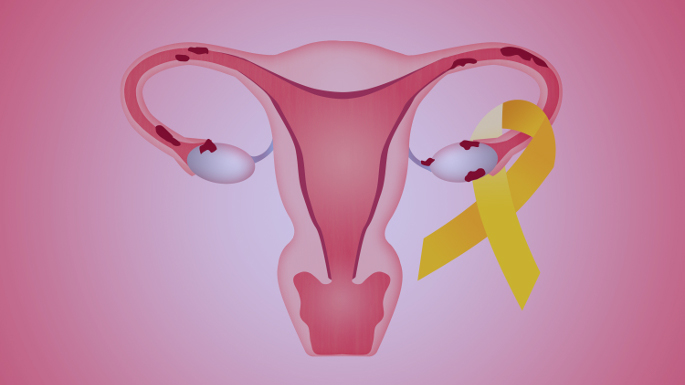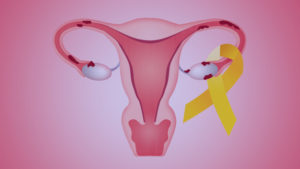
05 Aug Endometriosis!!!
“Sweetie, what is it?” he asked, turning on the bedside lamp to look at her. Her face was tight with pain as she blinked rapidly, trying to adjust her eyes to the sudden brightness.
“I can’t sleep,” she replied, her face twisted in a grimace. “My menstrual pain seems worse than usual,” she added before he could ask.
“I’m so sorry,” he replied, reaching over to draw her into his arms. “Have you taken anything yet?”
“I already took Ibuprofen.”
“You will be fine,” he murmured, “Just give the drugs time to work.”
All night, he listened to her groans and moans. At times, he was sure he heard sobbing. Chi-chi had always experienced painful menstruation but sometimes, it was so terrible, like now. All her life, she had been asked to ‘Suck it up and endure it like a woman’. An elderly aunt had reprimanded her, ‘If you cry for ordinary menses; what would you do during labor?’ Chi-chi had learnt to ‘suck it up like a woman’ but sometimes, the pain was just far above anything she could suck up.
The next morning, her husband dragged her to the hospital, it was a Saturday so she didn’t have any excuses, he had said. As they walked into the Doctor’s consulting room, Chi-chi briefly wondered at what her elderly aunt would say if she heard that she was seeing a doctor because of ‘common menstrual pain’.
After what seemed like an inordinate amount of questioning, the Doctor suggested pelvic examination and a trans vaginal scan and asked her to change into a hospital gown and lie on the examination couch. As the Doctor conducted the pelvic examination, Chi-chi looked pointedly at his face, trying to see any change in his very impassive expression but it had remained the same. She tried not to squirm whilst feeling his probing fingers inside her. When he was done, he muttered a single “hmmmph” and picked up a strange looking object which he wiped clean and to her utmost surprise, he tore open a sachet of condom and wore it over it.
On noticing her open mouthed stare, he explained, “This is a transducer for the trans-vaginal scan, it goes into your vagina and helps me view your inside.” After the scan which took a grueling, almost unending 10 minutes, she was allowed to dress up.
“There are many causes of painful menstruation in women but yours is Endometriosis,” he began calmly.
“What?”
“Endometriosis,” he repeated gently.
“I don’t understand,” she said softly. Her husband squeezed her hand softly, his way of saying ‘be calm’. She took a deep breath to calm herself, “What is Endometriosis?”
“I am going to explain as much as I can but I will give you pamphlets to read.”
Chi-chi listened with half an ear to the Doctor’s talk, her brain picked up a word here and there, discarding the rest. All she wanted to do was curl up and cry. The Doctor said something about endometriosis being a cause of infertility and she thought, maybe it’s why I can’ get pregnant. Maybe. She had been married for two years and yet no sign of pregnancy, not even a miscarriage. She waited patiently for the Doctor to mention the treatment and when he said, ‘There’s no definitive cure’, her husband had quickly squeezed her hands, expecting her to fly into a rage but she slumped back on the seat, an absolute picture of defeat. They left the hospital in silence and when they got home, Chi-chi spent the rest of the day reading up on Endometriosis. She always believed that if you know your enemy, you would know how to defeat him. She would find out as much as she could about this Endometriosis. By the end of the day, she was certain she knew enough.
Endometriosis is an often painful disorder in which tissue that normally lines the insides of the uterus-endometrium-grows outside the uterus. It occurs in women of reproductive age but usually between 25-40 years. It commonly involves the ovaries, bowel or the tissue lining the pelvis, rarely it could be found outside the pelvic region. This endometrial tissue that have strayed from the uterus into other parts still act as endometrial tissue no matter the location so with each menstrual cycle, it thickens, breaks down and bleeds. And because there is no way for it to exit the body, it becomes trapped.
SYMPTOMS:
Symptoms mostly depend on the location of the endometrial tissue.
a. Dysmenorrhea (Painful periods)- The pelvic pain and cramping is usually severe and may include lower back and abdominal pains. This pain may not respond to Non steroidal anti-inflammatory drugs (NSAIDS) eg Aspirin, Ibuprofen, Felvin etc.
b. Dyspareunia (Pain with intercourse)- There is pain during and after sex.
c. Excessive bleeding- The periods are heavy (menorrhagia) and there may be bleeding between periods (menometrorrhagia)
d. Pain with bowel movements or urination (dysuria)- These symptoms occur mostly during the cycle.
e. Infertility- This maybe due to the adhesions in the fallopian tubes or ovaries, also due to the severe pain during sex (dyspareunia) , the couple might not be able to have sex and without sex, there is no conception.
f. Other symptoms- fatigue, diarrhea, constipation, bloating or nausea especially during menstrual periods, cyclical pain or bleeding from umbilicus (navel) or abdominal scars.
CAUSES:
The causes are not known but there are theories.
a. Retrograde menstruation- This is the most likely explanation for endometriosis. The menstrual blood containing endometrial cells flows back through the fallopian tubes and into the pelvic cavity instead of out of the body. These displaced endometrial cells stick to the pelvic walls and surfaces of pelvic organs where they grow, continue to thicken and bleed over the course of each menstrual cycle.
b. Inflammation- This can activate macrophages which in turn increase the ability to the endometrial cells to implant through a cascade of cytokines.
c. Genetic theories- Some chromosomes have been implicated in the inheritance of this. There’s a familial tendency to inherit it if you have a sister, mother or aunt with endometriosis.
d. Surgical scar implantation- After surgery such as hysterectomy or Caesarean section, endometrial cells may attach to a surgical incision.
e. Immune system disorder- A problem with the immune system may prevent the body from recognizing and destroying endometrial tissues growing outside the uterus.
SITES:
Ovaries, fallopian tubes, uterine ligaments, pelvic and back walls, intestines especially the rectrosigmoid, urinary bladders and ureters. It may also present with skin lesions as seen in cutaneous endometriosis.
DIAGNOSIS:
a. Health history- The Doctor asks questions and if there’s a positive answer to questions like pain during and after sex, painful periods, pain during urination, lower abdominal pain and backache etc, it may lead him to suspect endometriosis. The menstrual history is also very important.
b. Pelvic examination- Presence of endometrial growths may suggest Endometriosis.
c. Ultrasound- Trans-abdominal or trans-vaginal ultrasound is done, though not a definite confirmatory test, cysts associated with endometriosis can be identified.
d. Laparoscopy- A camera is inserted into an incision around the umbilicus (navel) and used to look inside the abdominal cavity. It is the most confirmatory method of diagnosis. Many hospitals in Nigeria now perform laparoscopy.
e. Barium enema- It is useful in determining the degree of bowel involvement.
STAGING:
A person with stage 1 may have little disease and severe pain, while a person with stage 4 may have severe disease and no pain or vice versa.
Stage 1(minimal) – Superficial lesions and possibly very few adhesions.
Stage 2(mild) – Superficial and deep lesions, some adhesions.
Stage 3(moderate)- As above but more adhesions and presence of endometriomas.
Stage 4 (severe)- As above plus large endometriomas and extensive adhesions.
PREVENTION:
There’s little evidence that use of Combined oral contraceptive pills (COC) is associated with reduced risk.
RISK FACTORS:
These are factors that place one at the risk of developing it.
a. Never giving birth.
b. One or more relatives with it (mother, aunt, sister)
c. Any medical condition that prevents the normal passage of menstrual flow out of the body eg Imperforate hymen (the hymen is not perforated hence there is no outflow point for menstrual blood which now accumulates causing a bulge in the vagina). Some of this blood flow back ie retrograde flow which we already pointed out as a possible cause of Endometriosis.
d. History of pelvic infection.
e. Uterine abnormalities.
MANAGEMENT:
There is no definitive cure for it so the management is focused on relief of pain and treatment of Endometriosis associated infertility.
a. Pain medication-
Non steroidal anti-inflammatory drugs eg Ibuprofen, Diclofenac and Opioids eg Morphine sulphate tablets help with the pain.
b. Hormones-
i) Hormonal contraception therapy- Combined oral contraceptive pills may reduce menstrual pain associated with endometriosis.
ii) Progesterone and progestins- They counteract estrogen and inhibit the growth of endometriosis. Eg- Moresthisterone, medroxyprogesterone.
iii) Gonadotropin releasing hormone agonists and antagonists- They lower estrogen levels and prevent menstruation, causing the endometrial tissues to shrink. These agonists and antagonists can force endometriosis into remission but have menopausal side effects eg hot flashes, vaginal dryness, bone loss and depression etc. Hormone replacement therapy or Tibolone can help with the menopausal effects. Agonists include- Nafarelin nasal spray 200mg or 400mg twice daily, leuprolide acetate; a depot preparation lasts monthly, goserelin.
iv) Medroxyprogesterone(Depo-vera)- Halts menstruation and growth of endometrial implants, thereby relieving the signs and symptoms of endometriosis, its side effects are same as menopausal symptoms.
v) Danazol- The drug suppresses growth of the endometrium by blocking the production of ovarian stimulating hormones. It causes serious side effects and is no more in use.
c. Conservative surgery-
Laparoscopic surgery- Aim at destroying endometriotic sites in cases where fertility is desired, also adhesions are excised.
d. Treatment of Endometriosis associated infertility-
Endometrial tissues can be removed to preserve the ovaries depending on the stage and level of adhesions. IVF procedures are helpful in improving fertility in women with endometriosis.
e. Lifestyle and home remedies-
Regular exercise, warm baths and heating pads can help relieve pelvic muscles and reduce pain and cramping.
f. Alternative medicine-
Acupuncture treatment has been reported to provide relief.
g. Proper counseling-
This can help the woman cope with the symptoms.
PROGNOSIS-
Research shows that it recurs at the rate of 20-40% within 5 years following conservative surgery unless hysterectomy is performed or menopause reached.
“Chi-chi, dinner is ready,” her husband called from the dining room. Since they returned from the hospital, she was sprawled out in the sitting room with her laptop, taking serious notes. “Chi-chi,” he called again.
She stretched and yawned. “I’m coming,” she replied. She was satisfied with her discovery. Earlier that day, Endometriosis was a strange and exotic sounding word, now she had knowledge and if knowledge is truly power, then she was empowered.





No Comments